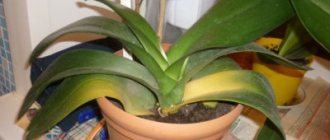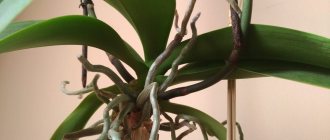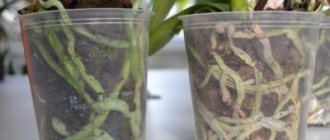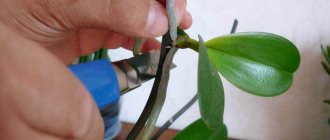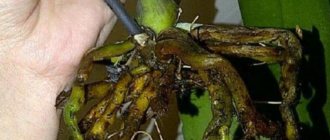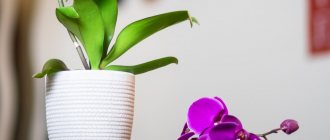In this article we will answer the question of whether it is possible to trim the roots of an orchid.
The orchid is considered an exotic flower. The plant decorates the windowsills of houses and offices. Despite the fact that the culture has been known for a long time and is popular, few people know how to properly care for it and safely trim the roots of an orchid. In addition, only a few maintain optimal temperature conditions, humidity levels, and take care of lighting and irrigation systems. However, their efforts will be in vain if the wrong roots are removed.
Features of the root system
Orchid aerial roots are roots that grow outside of the potting medium. They can grow from stem nodes at the top of the stem or emerge from potting soil. Some orchids produce many aerial roots, while others have few or no roots.
Orchids are natural epiphytic plants. This means they grow on other plants rather than in soil. Roots are responsible for anchoring the plant in place of growth, as well as for absorbing necessary water and nutrients.
Aerial roots are not that rare. But if you are new to growing phalaenopsis orchids, this term may not be familiar to you. The appearance of roots above the surface of the pot does not mean that the orchid has become cramped in the pot and needs to be replanted - just air outlets have begun to grow in the plant.
Also find out what to do if the peduncle of an orchid has dried up.
Structure
The structure of phalaenopsis aerial roots is very different from the structure of ordinary roots of land plants. The spongy tissue velamen covers the inner filamentous part of the root with a thick layer of epidermal cells. Velamen helps orchids cling to tree branches, absorb water and nitrogen from the air , protects them from damage and retains moisture, thereby providing water to the entire plant and protecting it from drying out.
Aerial roots are natural to epiphytic species that grow on other plants in tropical forests. Unlike terrestrial orchids, which root in the ground, epiphytic species naturally grow above ground, using their roots to attach themselves to tree branches and reach brighter areas among the foliage.
Unlike other plants that attach themselves to trees, phalaenopsis orchids are not parasitic or invasive. Epiphytes, with a unique root system, use their roots to absorb nutrients, moisture and carbon dioxide to grow and survive directly from the air, without feeding on tree sap .
We recommend reading how to propagate an orchid from cuttings at home.
Appearance
Although aerial roots do not improve the aesthetic appearance of the flower, nothing needs to be done with them - this is the natural development of the plant. They are cylindrical or flat in shape and should be firm to the touch.
The aerial roots become bright green immediately after watering, which is a sign of healthy roots. As they dry, they first turn silver and then gray or whitish, which means that the orchid may need watering . Just soak the roots for 2 minutes or spray them with water and they will turn green again.
Conclusion
As you can see, there are many reasons for orchid root disease, but the main ones are the abundance of moisture and lack of light. If you follow these factors while caring for the plant, then you will need to resort to root pruning very rarely.
Ideally, the roots of phalaenopsis should be removed no more than once every two years, and then only old dried shoots should be trimmed. But even with significant damage to the root system, the plant can still be saved. It all depends on the number of living orchid shoots. If after pruning it still has at least one healthy root 5-6 mm long, then we can hope for the flower to recover. To do this, it is recommended to plant the orchid in a small narrow pot and place it in a well-lit, warm place. You need to water the flower in the same way as a healthy plant, that is, irrigate after the substrate has completely dried. With proper attention and care, the phalaenopsis' root system will grow again and it will delight its owners with its beautiful delicate flowers.
The reason for the appearance of aerial roots
The growth of a plant and its root system is a natural cycle of development and renewal, so the appearance of new roots more often indicates the healthy and proper development of the orchid . The appearance of 2-3 aerial roots is normal and should not cause concern.
But sometimes the reason for the intensive growth of aerial roots above the potting substrate can be excessive moisture or increased dryness and too warm air (for example, when located next to a heating radiator) - growing out of the pot, the flower tries to find a more comfortable place.
Read more about how to care for orchid roots.
How to distinguish dead roots from living ones?
It is quite difficult to visually distinguish living shoots from dead ones. But knowing the features of the phalaenopsis root system, this can be done with the help of water. To do this, the plant must be removed from the pot and immersed in a container of water. If the roots in the water have acquired a bright green tint, then they are healthy. If their color has not changed, it means that the shoots are dead and need to be removed. Also, a disease of the shoots is indicated by a violation of the outer layer of velamen, for example, if when pressed it is easily removed, exposing the internal tissues of the root.
There is an easier way to determine the “sick” roots of an orchid. So if you lightly squeeze the shoot with your fingers and it turns out to be empty or a slimy liquid comes out of it, then it is dead.
How are they different from regular ones?
Aerial roots are similar in many ways to normal roots growing in a substrate—it's just a different root arrangement. They are slightly thicker and are the healthiest on the plant, as they grow in conditions close to the flower's natural habitat.
Household orchids are usually grown in a soilless mixture based on pine bark or sphagnum moss to mimic natural growing conditions in trees . Over time, this potting mix breaks down and requires replacement, and the internal roots are at high risk of developing root rot and fungal infections.
The orchid seeks new sources of nutrients, light and moisture, so its roots twist and turn in all directions, but most of them remain in the drainage pot. If the orchid does not have above-ground roots, then most likely when they appear, they are rooted in the substrate
Why does an orchid need aerial roots?
The health of an orchid depends on the condition of its root system. Aerial roots actively participate in photosynthesis and serve to replenish moisture reserves and further use it.
Functions of air roots:
- fastening and support - epiphytes have completely abandoned underground roots and use aerial roots to anchor themselves on tree branches;
- absorbing water from the environment and storing it for use in drier conditions;
- obtaining nutrients from water, air and symbiosis with fungi (mycorrhiza);
- photosynthesis - similar to leaves, they convert light energy into carbohydrates necessary for plant growth.
Did you know? Orchids, known as lithophytes, use a similar anchoring strategy to epiphytic species, but are anchored on rocks rather than trees.
The orchid has many above-ground roots
Sometimes a large number of above-ground roots indicates the need to transplant the flower into a larger pot.
Orchids generally like to be root-bound to the substrate, just like a tree in its natural environment, so most of the root system remains in the pot. However, as the plant grows, the potting medium becomes so clogged with roots that they become crowded and grow outward. In such cases, you should consider replanting the plant.
Reason 2: inappropriate pot volume
If there is no replanting for a long time, another problem may arise - the orchid simply outgrows its pot. Moreover, the better conditions the plants are kept in, the faster this process occurs.
Determining that the roots have become too crowded in the pot is quite simple:
- through the walls of the container it is noticeable that the roots have completely mastered the volume and are interfering with each other;
- individual roots began to grow through the drainage holes;
- the plant appears “lifted” because the growing root system pushes it out of the pot.
An orchid that has outgrown its pot is easy to recognize - it falls on its side, and if the container is too light, it may even turn over.
Is it possible to trim and when to do it?
A flower's aerial roots should not be pruned because they are a living part of the system the plant uses to absorb nutrients and water. Trimming aerial roots can cause the plant to become sick or even die due to disease or inability to absorb enough elements to grow.
Important! Any unhealthy roots should be removed to healthy tissue using sterile instruments (wipe with alcohol or heated over fire), and the cut areas should be dried and treated with activated carbon or cinnamon powder.
There are several ways to control aerial roots:
- double pot - the main container with the substrate is placed in a decorative pot, which hides part of the air outlets;
- replanting the orchid into a large container with deepening the roots that have crawled out of the potting mixture beyond its boundaries. At the same time, you should not bury the aerial roots growing on the stem.
Only diseased, dry, dead and damaged parts of the roots should be removed. Trimming is carried out until healthy and clean tissue
Step-by-step instructions: how to carry out the procedure correctly?
It is advisable to prune dead roots when your flower has already bloomed and is at rest.
But there are times when replanting a plant and pruning putrefactive formations is urgently necessary. Then you have to choose between blooming and saving the flower. So, you've decided to trim. If the orchid is in bloom, then first of all you need to remove the peduncle. Alas! Beautiful flowers will have to be sacrificed.
This must be done so that the flower’s forces are switched to the creation and growth of a new healthy root system.
Preparing tools
To remove infected and dry roots, you need to prepare the following tools and devices:
- Knife (scissors, pruning shears).
They must be well sharpened so that unnecessary roots are removed in one motion. It is not advisable to use nail scissors for this procedure. They are too small and can cause irreparable harm to the plant. - Antiseptic for disinfecting instruments. In the absence of such, burning the instrument with fire is allowed.
- Medical rubber gloves. They are necessary not only to protect your hands, but also to prevent substances on the skin of your hands that are unnecessary for the plant from getting onto the cut plant.
- Powdered activated carbon (if unavailable, can be replaced with charcoal). It will protect fresh cuts from drying out and infections.
- Oilcloth and a new pot (if the old pot is the right size for your orchid, you can use it after treating it with an antiseptic).
Search for roots
First you need to carefully remove the orchid from the pot, being careful not to damage the root system. This is easiest to do when the soil is dry. Then shake off the roots from the soil
If that doesn’t work, carefully untangle the roots with your hands and remove excess substrate. Let's move on to inspecting the root system. Rotten roots can be seen immediately, they acquire a peculiar brownish color and are distinguished by excessive moisture. We check dried roots with water to see if they are capable of further vital activity
If not, feel free to classify them as circumcised.
So, we have identified the roots that need to be removed.
Process
- Cover the table with oilcloth.
- Wear rubber gloves.
- Treat instruments with an antiseptic.
- Cut off damaged roots with a knife:
- If the rot is located only in the lower part of the root, only the affected area needs to be cut off.
- If the root has rotted at the base of the flower, it is cut off completely.
- Treat the sections with an antiseptic.
How to treat the damaged area?
A cut for a plant is like a wound for a person. Through it, the flower can become infected. Therefore, processing the cut is a mandatory procedure when cutting roots. There are several ways to process slices:
- Crush the activated carbon tablet into powder and sprinkle on the cut area.
- You can do the same with charcoal.
- A good anti-rot agent is sphagnum moss. It must be crushed and applied to the cut site.
- Manganese solution. Process the cut area.
- Zelenka. Process the cut area.
- Ground cinnamon is an excellent fungicidal agent for treating orchid cuttings.
Do not treat cut areas on orchid roots with vodka or alcohol. They can dry out healthy roots.
After the cut areas of the orchid have been treated, a vitamin compress can be applied to the exotic roots. To do this, dilute 1 ampoule of vitamins B12, B1, B6 in 1 liter of water. Place the roots of the flower in this solution and keep them there for 10-15 minutes.
Problems and their possible solutions
The aerial roots of epiphytes do not require special care - they will also be healthy if you take good care of the flower itself. However, they may experience the same problems as the stems and roots inside the pot.
Why do orchid roots dry out?
If the roots are gray, dry and wrinkled, or there are no growing tips on them, then the orchid is not receiving enough moisture. This may occur due to the coarse fraction of the potting mixture, which does not allow the roots to better contact the substrate when watering.
We recommend reading how to revive an orchid if its roots dry out.
Low air humidity in the room, which often occurs during the heating season, is also the cause of dry roots - you can place a container of water near the plant and spray it regularly. Try to keep the humidity above 40% to prevent the aerial roots from drying out too quickly.
The roots can also dry out when exposed to direct sunlight, especially at midday - try shading the orchid with a transparent curtain or moving it away from the window
Why does the root system rot?
When roots begin to rot, they become brown and soft and cannot properly absorb water and nutrients. The only thing you need to do to help the plant is to trim the rotten roots back to healthy tissue.
Important! Sometimes the roots turn brown due to hard water and salt deposits on their surface. But unlike rot, salt stains are hard and similar to rust.
The causes of rot can be excessive watering and stagnation of water in the substrate, as well as high concentrations of fertilizers and incorrect temperature conditions.
Only aerial roots remain
If for some reason the flower has only aerial roots left, then the following planting option will help the plant recover:
- cut off all problem roots at the base and sprinkle the sections with cinnamon or activated carbon. Dry the orchid in the air for 3–5 hours so that the wounds from the cuts heal and dry;
- prepare a pot according to the volume of the root system with holes for draining water and ventilation;
- use a fine fraction of bark as a substrate, and lay a layer of sphagnum (1 cm) on top, after dousing it with boiling water;
- give the flower a reliable support so that it does not wobble or tip over in the pot, injuring the roots. Place the root collar at the very surface of the substrate - all parts of the orchid should be in the air and not touch the water;
- leave aerial roots on the surface;
- water not by submersion, but by generously spraying sphagnum moss to stimulate root growth down to the moist surface.
Important! The orchid is very tenacious and can survive by using aerial roots.
Moldiness
Mold on a plant can appear due to decomposition of the potting mixture, excessive humidity and high temperature, which leads to the pot fogging and condensation. In such cases, it is necessary to change the conditions of keeping the orchid and dry the substrate.
Mold is sometimes caused by fungal microorganisms, and here you will need to replant the flower with replacement of the mixture and treatment with fungicides
Aerial roots turn black
Blackening of the roots can occur for the following reasons:
- the plant was exposed to direct sunlight for a long time and received burns. Such blackening is also possible on the leaves;
- long-term decrease in temperature (+4...+6°C) with high air humidity;
- watering or spraying with cold water;
- increased concentrations of fertilizers (only a quarter of the specified norm of flower fertilizers is required);
- deposition of salts in the substrate when watering with hard water;
- pathogenic diseases.
Find out what to do - the orchid's leaves are falling.
Plant care
Caring for orchids is simple and does not require much effort - just learn the basics:
- Most epiphytes require moist and well-drained mixtures . There are several types of nutrient media that can be used for plants - fir or pine bark, sphagnum peat, stones, cork, charcoal, sand. The fraction of the bark depends on the type of orchid being grown - the coarse fraction is suitable for phalaenopsis, but the plant should not be buried.
- The best location would be windows facing east or south - the plants in question prefer diffused, indirect bright light . Lack of lighting leads to poor flowering, and direct rays at midday can cause leaf burn.
- Temperature and humidity are also important for indoor orchids. A temperature of +18°...+25°C and a humidity of 60% throughout the growing season are considered comfortable, but for the plant to bloom, the night temperature must be 8–15°C lower than the daytime temperature.
- The flower is watered by immersion once every 10–14 days. This is the only case when the epiphyte roots remain in water, but for no more than 3–5 hours. It is advisable to use soft or boiled water, with a temperature of about +30...+35°C. The flower should dry well between waterings.
- During the growing season and plant growth, use a weak solution of houseplant fertilizer every time you water it. No fertilizing is carried out during flowering .
- The flower is replanted every 2 years with a complete replacement of the substrate.
- It is necessary to carefully monitor the plants in order to promptly notice signs of disease or pest damage and take action.
- At home, the phalaenopsis orchid reproduces by children , which grow on peduncles or stems. Propagation by seed or tissue culture is best left to commercial growers as it requires special laboratory equipment.
How to distinguish between healthy and diseased roots
It is important to learn to distinguish living roots from dead ones. This can be done by visual inspection. To do this, you should perform simple manipulations. Place the flower in a container filled with water and observe the roots. If they are bright green and flexible, then there is no doubt - they are alive and healthy. If, after “rinsing” in water, the roots still remain gray in color and other external signs do not change, then we ascertain their “death.”
Another way to detect dead roots is to break the durable surface layer. The easiest way to identify diseased roots is to press your fingers on an airy shoot, and if you find that it is empty inside and slimy water runs out, then rest assured, it is dead. Rotten and dead roots can be disposed of without regret. This will not only not harm the flower, but, on the contrary, will help maintain health. Roots can rot due to excessive watering. A large number of fungi “settle” on the root system. Under normal conditions, they cannot harm the plant. When watering is excessive and lighting is insufficient, the top layer of aerial roots becomes filled with liquid, which creates a favorable environment for the proliferation of harmful microorganisms.
Another reason is the compaction of the substrate. The main property that soil for orchids should have is good breathability. Over time, the soil begins to compact and the root system lacks oxygen. If the light is good, then the air moves along the stems.
Lack of light aggravates the situation, which leads to a decrease in the rate of evaporation of excess moisture and, as a result, the roots rot. Also, due to their fragility, orchid roots can suffer mechanical damage during the replanting process.
A high content of phosphorus and potassium salts in fertilizing can lead to burns of the roots, as a result of which they begin to poorly absorb moisture and dry out.
Orchid transplant
Repotting is necessary to ensure good health and optimal growth of the plant. If an orchid remains in the same pot for a long time, the flower will begin to weaken and fade. Over time, the substrate decomposes and becomes compacted, its air permeability is impaired, and the plant lacks air, which will increase the risk of disease and lead to stress.
The frequency of repotting depends on the type of orchid and the type of potting mix. An orchid must be replanted regularly, and phalaenopsis only benefit from frequent replanting. Be sure to use new potting mix when doing this. A composition made from crushed coconut shells will last longer than a mixture of fir or pine bark.
Did you know? Vanilla is the most famous and widely used spice and is obtained from the only commercially grown orchid.
Some experienced gardeners believe that using a mixture of perlite and peat in the potting mix produces fewer aerial roots than pine bark. In any case, when replanting, do not deepen the aerial roots, because they may rot. The new pot for the plant should be transparent and have drainage holes to drain water so that the orchid's roots are not in the water.
An orchid transplant is necessary in the following cases:
- a recently purchased flower is replanted to assess the quality of the roots and general condition, but if it blooms, you should wait until the end of flowering;
- the growth and development of the plant leads to the fact that the pot becomes cramped, and the flower needs a larger container;
- a pot that is too large is also a reason for replanting a flower, since the orchid will grow roots to the detriment of the development of the leaf part and flowering;
- there are signs of disease or pest damage.
Reviews from flower growers about cut processing products
Orchid lovers use any methods to disinfect and heal sections, sometimes very exotic ones - even cauterization with a soldering iron. However, the less extreme means listed above are still used more often:
“I usually take what I have on hand. Mainly green stuff, cinnamon or crushed charcoal. Everything always heals well. A young leaf on one of the orchids recently rotted; I didn’t even have to trim it - it pulled itself out of the bosom. I was afraid that the growing point had disappeared, but I sprinkled it with cinnamon without cutting anything. After 2 weeks I saw that a new leaf had hatched” (Irina, Severodvinsk).
Before trimming the roots, it is useful to hold the orchid in a solution of potassium permanganate for several minutes. The rest of the procedure is carried out after drying.
